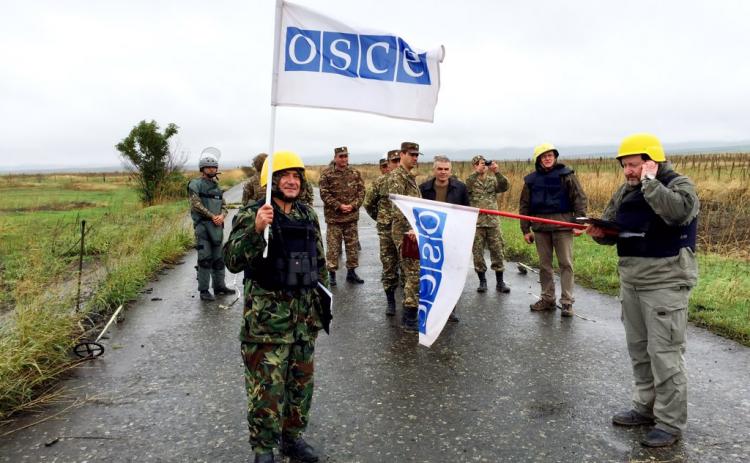VIENNA, Austria (A.W.)— The Organization for Security and Cooperation in Europe (OSCE) recently released their 2016 annual report. The report, which summarizes the organization’s activities in the last year, assesses the situation in Artsakh (Nagorno-Karabagh) and the OSCE’s work in helping resolve the conflict.

OSCE Monitors during a 2015 monitoring (Photo: OSCE)
The report stated that the escalation of tensions in April 2016 “intensified” efforts for crisis management.
“With regard to the Nagorno-Karabagh conflict, the Chairmanship reacted swiftly after the escalation of hostilities at the line of contact in April 2016, initiating a special meeting of the Permanent Council (PC) and advocating the implementation of agreements reached at the presidential level in Vienna and St. Petersburg concerning the expansion of the Office of the Personal Representative of the Chairperson-in-Office, Ambassador Andrzej Kasprzyk, and the establishment of an investigative mechanism,” read a section of the report.
According to the report, the resumption of a political negotiation process to settle the conflict was emphasized during the increased tensions of the conflict. It also added what steps were taken immediately after the 2016 April War, including the organization’s special meeting that took place after the outbreak of aggression.
In the report, Ambassador Andrzej Kasprzyk called 2016 a “difficult year” and mentioned how this year faced the largest number of casualties since the ceasefire was implemented in 1994.
The report went on to provide a synopsis of the events that followed the April War, including the humanitarian operations and the meetings of the Personal Representative of the Chairperson-in-Office with leaders of Armenia and Azerbaijan.
Kasprzyk was able to visit the region a total of eight times. The details of several monitoring missions were also summarized in the report. “With the support of the sides, the Personal Representative and his team conducted 22 monitoring exercises, five on the Armenian-Azerbaijani border and 17 on the line of contact. Representatives of the High-Level Planning Group were also able to take part in four monitoring exercises in February, May, July, and October,” read a part of the report.
The OSCE report also included a section entitled “Office in Yerevan,” where it addressed how the office in Yerevan was successfully assisting in the work of the OSCE. According to the report, the office in Yerevan primarily focused on “supporting security sector governance and reform, economic integration, the rule of law and the promotion of human rights and fundamental freedoms.”
VIENNA, Austria (A.W.)— The Organization for Security and Cooperation in Europe (OSCE) recently released their 2016 annual report. The report, which summarizes the organization’s activities in the last year, assesses the situation in Artsakh (Nagorno-Karabagh) and the OSCE’s work in helping resolve the conflict. OSCE Monitors during a 2015 monitoring (Photo: OSCE) The report stated that the escalation of tensions in April 2016 “intensified” efforts for crisis management. “With regard to the Nagorno-Karabagh conflict, the Chairmanship reacted swiftly after the escalation of hostilities at the line of contact in April 2016, initiating a special meeting of the Permanent Council (PC) and advocating the implementation of agreements reached at the presidential level in Vienna and St. Petersburg concerning the expansion of the Office of the Personal Representative of the Chairperson-in-Office, Ambassador Andrzej Kasprzyk, and the establishment of an investigative mechanism,” read a section of the report. According to the report, the resumption of a political negotiation process to settle the conflict was emphasized during the increased tensions of the conflict. It also added what steps were taken immediately after the 2016 April War, including the organization’s special meeting that took place after the outbreak of aggression. In the report, Ambassador [...]
VIENNA, Austria (A.W.)— The Organization for Security and Cooperation in Europe (OSCE) recently released their 2016 annual report. The report, which summarizes the organization’s activities in the last year, assesses the situation in Artsakh (Nagorno-Karabagh) and the OSCE’s work in helping resolve the conflict. OSCE Monitors during a 2015 monitoring (Photo: OSCE) The report stated that the escalation of tensions in April 2016 “intensified” efforts for crisis management. “With regard to the Nagorno-Karabagh conflict, the Chairmanship reacted swiftly after the escalation of hostilities at the line of contact in April 2016, initiating a special meeting of the Permanent Council (PC) and advocating the implementation of agreements reached at the presidential level in Vienna and St. Petersburg concerning the expansion of the Office of the Personal Representative of the Chairperson-in-Office, Ambassador Andrzej Kasprzyk, and the establishment of an investigative mechanism,” read a section of the report. According to the report, the resumption of a political negotiation process to settle the conflict was emphasized during the increased tensions of the conflict. It also added what steps were taken immediately after the 2016 April War, including the organization’s special meeting that took place after the outbreak of aggression. In the report, Ambassador [...]
[img][/img]
More...